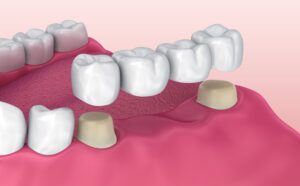If you have missing teeth, including front teeth, a dental bridge can help restore the look and function of your teeth. It bridges the gap where the missing tooth is. Talk to a dental professional to find out if it’s right for you.

What are dental bridges?
If you have one or more missing teeth, a dental bridge can fill the gap with one or more artificial (false) teeth. A bridge is typically made of crowns on either side of the missing tooth or teeth supporting the pontic (false tooth) and is cemented in place.
Who needs a dental bridge?
Dental bridges can help if you have a missing tooth or teeth. The most common causes of missing teeth are tooth decay, gum disease and injury. Or you may have been born with missing teeth due to a congenital condition. To get a dental bridge, you need healthy teeth on either side of the missing ones.
Why do I need a dental bridge?
Your teeth work together. If a tooth is missing, nearby teeth can move into the empty space. The teeth in your opposite jaw can also move up or down toward the space. This can cause:
- Bite problems.
- Chewing difficulties.
- Pain from the extra stress on your teeth and jaw.
- Self-consciousness about the way you look or your smile.
What does a dental bridge look like?
A typical dental bridge has:
- Abutment teeth: A dental professional places two crowns on the teeth on either side of the gap. These anchoring teeth, or supporting teeth, can be your natural teeth or dental implants.
- Pontics: This false tooth (or teeth) fills in the gap and attaches to the crowns.
What types of dental bridges are available?
The four main types of bridges are:
- Traditional fixed bridge: This bridge is the most common. It has two or more crowns and a filler tooth or teeth that are all connected. The crowns keep the bridge in place. Traditional bridges are made of metal, porcelain fused to metal, or ceramics.
- Cantilever bridge: In this bridge type, the pontic connects to only one abutment tooth. This can sometimes be an option for people who have teeth on only one side of the gap.
- Maryland dental bridge (resin-bonded bridge): You may have this type of bridge if you have missing front teeth. It’s made of porcelain fused to metal or ceramic teeth, supported by a framework. Wings on each side of the bridge bond to your existing teeth.
- Implant supported bridge: This bridge is similar to a “traditional fixed bridge” but instead of being cemented in place to teeth, it is held in place by implants.
What can I use instead of a dental bridge?
Some people choose partial dentures, which are removable false teeth. You take them out to clean them. You may also be a candidate for a dental implant. An implant is surgically placed in your jaw. Your dentist can help you figure out what the best option is for you.
Do I need dental implants?
Sometimes, your dentist may recommend a dental implant instead of a bridge. A dental lab creates new teeth based on a model of your mouth. A surgeon places the implant in your jaw. Over time, the implants integrate with the jawbone and are connected to the new teeth. An advantage of implants is that they don’t need support from the other teeth.
What happens during a procedure for a traditional dental bridge?
You’ll typically need at least two appointments:
- Abutment teeth preparation: During your first visit, your healthcare provider reshapes the abutment teeth. They’ll remove part of the enamel and dentin, so there’s room for the crown.
- Impressions: Your provider takes impressions or a digital scan of your teeth. A dental laboratory uses the mold or scan as a model to create your bridge, false teeth and crowns. You’ll have a temporary bridge to protect the exposed areas in your mouth while the lab makes your bridge.
- Permanent bridge placement: During your second visit, your provider removes the temporary bridge and places the permanent bridge. Your provider will carefully check the bridge and make any needed adjustments to make sure it fits you comfortably.

What are the advantages of this procedure?
A dental bridge can:
- Help your bite.
- Prevent remaining teeth from moving out of place.
- Restore your ability to chew and speak.
- Restore your smile.
Do dental bridges have any risks or complications?
If you care for your bridge properly, it can last many years without complications. The bridge may fail if the surrounding teeth decay or if the cement deteriorates. If the bridge comes loose and the supporting teeth are still healthy and intact, your provider may be able to re-attach it with new cement.
How long do dental bridges last?
With good oral hygiene and regular professional cleanings, the bridge may last more than 10 years.
Will the dental bridge change how I speak?
If you are missing front teeth, it can be hard to speak clearly. A dental bridge with front teeth in the right place can improve your speech.
How do I care for my dental bridge?
The success of the dental bridge depends on the health and strength of the remaining teeth. With a bridge, it’s especially important to prevent tooth decay and gum disease that can lead to tooth loss. For proper tooth and gum care, you should:
- Brush twice a day and floss daily: A dental professional can show you the right way to brush and floss. You will probably use a special type of floss called a threader that lets you slide the floss between the bridge and your gum.
- Get regular professional cleanings: Seeing a dental provider regularly can help detect problems early, when treatment is more successful.
- Eat a balanced diet: Include plenty of fruits, vegetables and fiber and try to limit chewy, fibrous foods like some meats.
